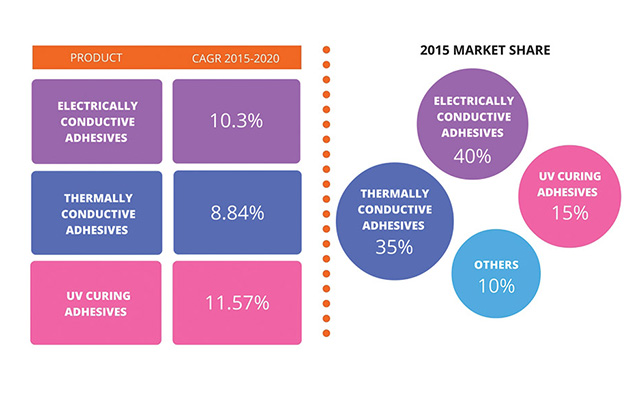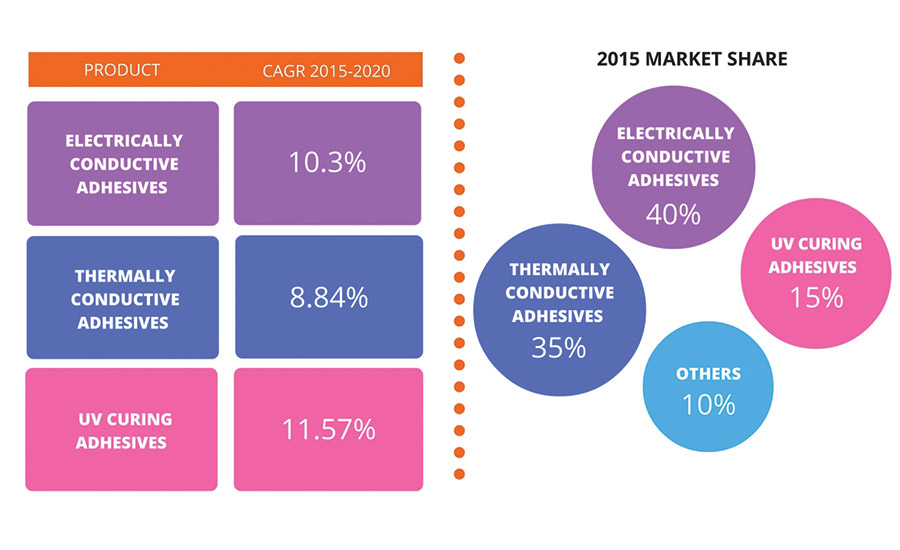Industry News, Adhesives & Sealants & Tackifiers
Continued Growth for Adhesives in Electronics

Industry News, Adhesives & Sealants & Tackifiers

The global electronic adhesives market is expected to grow at a compound annual growth rate (CAGR) of close to 10% from 2017-2021, according “Global Electronic Adhesives Market 2017-2021,” a recent report from Technavio.
“The use of electronic adhesives in the production of PCBs [printed circuit boards], which are the basic building block of the electronic industry and other electronic components, has grown tremendously over the years,” says Chandrakumar Badala Jaganathan, a lead analyst for additives, adhesives, and sealants research. “Thus, the growth of the electronics market that caters to various industries, including telecommunications, defense, computer, consumer goods, and automotive products, augurs well for the electronic adhesives market.”
The global electronic adhesives market for electrically conductive adhesives is expected to grow at a CAGR of over 10%. Electrically conductive adhesives will represent the highest share in the electronic adhesives market in comparison with other product types due to their high demand in many applications, such as bonding heat-sensitive electronic components and bonding glass, plastics, or soft metals.
Most of the organic and inorganic adhesives such as epoxies, acrylics, cyanoacrylates, silicones and urethane acrylates are not electrically conductive. However, in applications such as integrated circuits and surface-mount devices (SMDs), electrically conductive adhesives are required. Thus, a suitable filler is added to the base material to convert non-conductive adhesives into electrically conductive materials. Several fillers (e.g., silver, nickel and carbon) are used to confer electrical conductivity.

Figure 1. Global electronic adhesives market by product.
The global electronic adhesives market for thermally conductive adhesives is expected to grow at a CAGR of close to 9%. Thermally conductive adhesives are primarily used in electronic applications due to their superior heat dissipation. The adhesives offer essential properties for electronic applications such as chemical resistance, vibration resistance and superior electrical insulation.
The miniaturization of electronic circuitry leads to heat buildup, which results in internal failure of electronic components as their maximum operating temperatures are exceeded. Thermally conductive adhesives are used to tackle this problem and check such heat buildup in the electric device. Epoxies, silicones, and acrylics are the most commonly used thermally conductive systems for formulation.
The global electronic adhesives market for UV-curing adhesives is expected to grow at a CAGR of close to 12%. These user-friendly adhesives can be cured rapidly without additional temperature curing. UV-curing adhesives are typically acrylic-based formulations and consist of photoinitiators that are activated by UV rays.
UV-curable additives are used to protect circuits and maintain electronic assemblies. These adhesives are applied on the surfaces of PCBs to offer complete protection to the material from harsh environments or chemical exposure.
“The UV-curing adhesives segment is gaining momentum owing to its increased application in conformal coatings, encapsulation, bonding, keypad coatings, masking, thermal management, lamination, and display bonding,” says Chandrakumar.